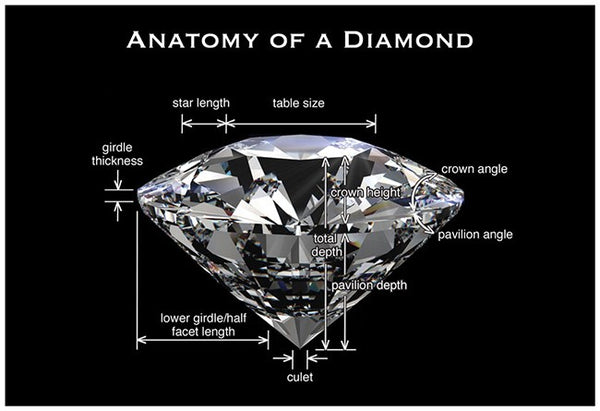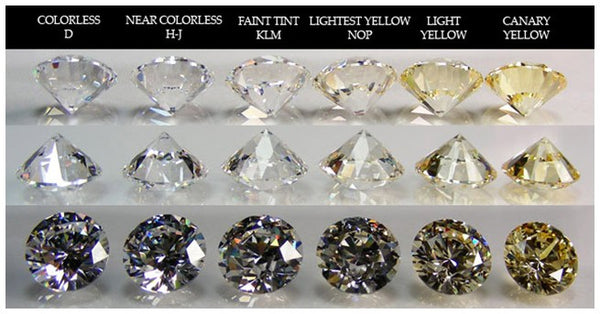Gemstone Cuts and The Four C's
There are several stages in the cutting of a gemstone each of which may be carried out by a different expert. As an example, a rough diamond crystal could be fashioned into a brilliant cut. This is the most popular cut for this stone because it maximises the gems natural strong light dispersion. However, because each stone is a different shape, or has imperfections within it, or because retaining the weight is of paramount importance, the cut in its ideal form (the "make") may not be possible. Nevertheless the essential aim is to make the diamond bright and sparkling showing flashes of colour called fire.
To this end the size, number and angles of the facets are mathematically calculated. The rough crystal is swan or cleaved to obtain a basic, workable piece, then turned on a lathe against another diamond to give it a round shape. The facets are then cut and polished in stages and the stone is given a final polish before mounting.

Brilliant Cut
Invented in the 18th Century this is the commonest cut used for Diamonds and is designed to reflect as much light as possible back up through the top. A brilliant cut stone has 56 facets, not including the table and culet. During the 19th Century the brilliant cut was constantly updated and developed. In the early part of the Century most stones were cushion-shaped (square with rounded edges - known as 'old cut') with a high crown, small table and large culet. By the end of the Century the crown became flatter and the table larger to allow more light to be reflected through the top of the stone (known as 'old european cut'). By 1910 most Diamonds were round rather than cushion-shaped (known as 'English round- cut brilliant'). The flat bottomed culet grew smaller and by C1920 it had become a sharp point (known as 'modern brilliant'). Most 19th Century stones, on close inspection, have facets which are not exactly symmetrical. This is common even in good-quality stones. With the availability of more advanced technology and cutting equipment in the 20th Century, facets became symmetrical.
Step Cut
The Step-Cut (or trap cut) shows coloured stones to advantage, having a rectangular or square table facet and girdle, with parallel rectangular facets. The corners of the fragile gems may be removed making octagonal stones as, for example, in most emeralds.
Mixed Cut
The mixed-cut stones are usually rounded in outline with the crowns (above the girdle) cut as brilliants and the pavilions (below the girdle) step cut. Sapphires, rubies and the most transparent coloured stones are cut in this style.
Fancy Cut
The fancy-cut stones have several possible outlines such as triangular, kite shaped, lozenge shaped, pentagonal or hexagonal. The cut may be used for rare gems or to make the most of a flawed or irregular shaped gem.
Old European Cut
See Brilliant Cut - an early form of brilliant cut showing the small table facet. Found mostly in antique jewellery.
Eight Cut / Single Cut
The eight cut is a modern version of the brilliant cut, usually used for small Diamonds of under 0.05cts. It has been used since 1910 and is less costly than the brilliant cut because it contains considerably fewer facets, and therefore wastes less material. Jewellery incorporating eight-cut Diamonds is usually less valuable than a piece using brilliants. The eight-cut creates a similar effect, however, the difference is not visible until examined through a lens.
Oval Brilliant Cut
See Brilliant Cut - used for many gemstones including Diamond.
Pearl Brilliant Cut
See Brilliant Cut - another commonly used cut, also known as a 'drop'.
Heart Brilliant Cut
A popular cut for engagement rings and used for many gemstones. This cut was popular as far back as the 18th Century and then again in the Edwardian Period.
Marquise Cut
Also called 'navette' or 'boat shaped' this is a modification of the brilliant cut. The shape was popular in 18th Century French court jewellery but fell out of favour until the late 19th Century. It has been in use ever since.
Square Brilliant Cut
See Brilliant Cut - also known as 'princess cut'.
Emerald Cut
So named as it is commonly used for Emeralds to show the 'garden' of the stone. This was developed in the 19th Century but not widely used until the 20th Century.
Baguette Cut
Also known as the 'step cut' and mainly used for larger coloured stones such as Emeralds or Sapphires.
Cabochon Cut
The cabochon cut is when a stone is polished unfaceted to give it a domed top. This has often been used for heavily flawed stones that would not benefit from faceting. This cut is almost always used for opaque stones such as opals and turquoises. This cut has been used since the 19th Century.
Cushion Cut
This is often used for Sapphires or Rubies and has a distinctive rounded pavilion.
Rose Cut
A very old cut dating from before the 16th Century. Mainly used for Diamonds, being an economical cut. These stones contain 24 triangular facets on the top and a flat base. The Victorians also liked blood-red pyrope garnets cut in this style.
Briolette Cut
A variation of the rose cut in extended form.
Proportions
The proportions are the angles, their measurements and their relationship to one another. The specific parts of the cut diamond measured are the table percentage of the diameter, the crown angle, the pavilion angle, The total depth percentage of the diameter, The crown height percentage of diameter, the pavilion depth percentage of diameter, lower girdle facet percentage of pavilion depth, the star facet percentage of the crown and the girdle thickness.

Finish
The finish is the quality of polish and the symmetry of the diamond and all the facets. The optical attributes of a diamond are Brightness, Fire and Scintillation.
Fire
Fire refers to the flashes of color resulting from the white light being dispersed into spectral colours.
Scintillation
Scintillation refers to the areas of light and dark when viewing the top of the diamond.
All these are factored with design and craftsmanship to assign a cut grade of Excellent, Very Good, Good, Fair or Poor using the GIA Cut-grading System for round brilliant cut diamonds.
The 4 C's
Carat
Diamonds are weighed in carats, the first C. One carat is equivalent to 1/5th of a gram. The carat measurement is metric so we further divide a carat into hundredths. Each hundredth is called a point. More small diamonds are found than large diamonds resulting in the higher price per carat for successively larger diamonds due to this inherent rarity.

Clarity
The second C is clarity and refers to the purity of the diamond. Diamonds are formed deep in the earth and are subject to tremendous heat and pressure which cause internal inclusions and external blemishes. Most diamonds have inclusions and key identifying characteristics and very few are flawless. We identify and grade diamonds based on these characteristics specific to their size, nature and location in/on the stone. Diamonds are graded by a skilled observer with 10X magnification using a binocular microscope or 10X loupe with optimum lighting conditions.
The grading categories range from flawless to imperfect.

Flawless
Flawless diamonds must be free from internal inclusions and external flaws. Internal graining not visible face up and without discoloration or small naturals on the girdle as long as they to not flatten the girdle are acceptable in the flawless grade.
VVS
Very, Very Slightly Included Diamonds are just that. These diamonds usually require a microscope to grade as the inclusions are very, very small and difficult for a skilled observer to see.
VS
The Very Slightly Included grade is used for diamonds that have very small internal and external characteristics that are difficult to locate with 10X magnification and a skilled observer.
SI
Slightly Included diamonds have small to medium sized inclusions that are obvious when examined with 10K magnification but usually not visible to the naked eye.
I1, I2, I3
Imperfect diamonds have medium to large flaws that are usually obvious to the unaided eye. Durability may be an issue with the lower qualities.
Colour
Diamonds occur in all colors of the rainbow however most diamonds range from colorless to light yellow or light brown. We use theGIA grading scale for color. The top color is D which is colorless. D,E and F are colorless to the human eye, G, H, I and J are near colorless,K, L, and M are faint yellow and the alphabet continues to Z and then diamonds have enough color to be called fancy. In order to determine the specific color range of a diamond we use a controlled lighting environment and master color grading diamonds for comparison. The chart above shows how little difference there is from one color grade to the next. Because colorless diamonds are purer with less chemical impurities to absorb light they are able to reflected and refracted more white light resulting in a brighter diamond. The more body color the diamond has the more light is absorbed.

